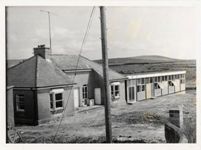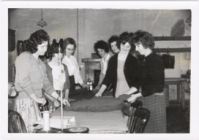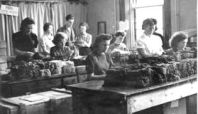Erris Lace Schools
Brief historical background by Helen Moreau ©
Caesar Otway (1780-1842) recorded in his 1841, “Sketches in Erris and Tyrawley” seeing a lace making class in Glengad in the early 1830’s. When the Congested Districts Board set up in Erris, County Mayo in the late 1890’s it sought to build on the earlier tradition of lace making as a viable and economic means of relieving poverty in the District.
To meet growing demand from luxury export markets (Paris, London, Rome, New York and San Francisco) for the exquisite Lace produced in Erris, the Congested Districts Board established 15 lace schools centres, scattered throughout the Barony. Maud Gonne (mother of Sean McBride) and her revolutionary foundation ‘The Daughters of Erin’ financed the establishment of a lace school at Porturlin. A widely dispersed and flourishing cottage industry developed from these centres.
From their establishment in the late 19th and early 20th centuries until their closures from the 1920s onwards the Lace Schools were the most successful venture undertaken by the Congested Districts Board in Erris. Women’s earnings from lace making helped alleviate the abject poverty that was the lot of the Erris people and brought about marked improvements in living standards; stock and poultry were purchased, homes and farms improved.
Such was the scourge of poverty in Erris that the only prospect awaiting single, unemployed women was emigration. As long as the Lace Schools prospered the tide of female emigration could be stemmed.
The business of each lace centre was conducted by an able manager appointed by the CDB. Her remit included the training and management of cottage workers; she supervised lace making classes and availed of the latest techniques and designs to satisfy market demands. She was a stern task master; high standards meant high earnings for her charges and high regard for the centre. She prepared lace entries for exhibitions & competitions. Most importantly she secured orders for her centre and when required she travelled to the fashion centres of Paris and London to attain her purpose.
These were sterling women who frequently braved real dangers during the periods of civil unrest and WW1 to ensure continued employment for their work force; there are numerous accounts of their intrepidness. Mrs Burke from the Muings Lace School was directed by the CDB to go to Harrods, London in 1917 and 1921, armed with a portfolio of fine samples she conducted her missions with brio. Special orders were undertaken for The British Royal family and other prestigious clients.
By 1914 the fashion for handmade lace was in decline and the event of WW1 heralded the beginning of the end of lace making as the main activity of the Erris lace Schools, (though The Muings School continued to attract substantial orders for lace). Traditional knitwear, already a staple came to the fore but of itself was not sufficient to keep the lace schools in full time business. The CDB’s officers made heroic efforts to secure work from Britain; a bulk order was taken for knitwear for front line troops. A shortage of buttons in Britain resulted in the CDB securing substantial orders for button making. The button boom lasted until 1921. A variety of light textile industries kept some of the Lace schools ticking over while others gradually closed down. Hand knitting, wool crochet and lace making continued in the cottages. Machine knitting was to become the main industry of the surviving Lace Schools.
In 1923 the Congested Districts Board handed its operations over to the Irish Land Commission. In the 1950’s Gaelterra Éireann assumed control, which then passed to Údarás Na Gaeltachta in the 1970’s.
The Muings lace School, Muings, and Barnatra
A successful lace school operated from The Lodge Foxpoint, a former landlord’s property acquired by the CDB in the late 19th century. In 1914 the CDB moved operations to the newly built Muings lace School, at Muings, Barnatra. It was to this establishment that Mrs Breege Burke was appointed manager in 1915 and whose efforts ensured continued employment during her tenure.
To satisfy the market for machine knit Aran-wear an extension was built in the 1930’s. A pre fabricated extension was added in the early 1970’s to cope with the need for more knitting machines. Throughout these years hand knitting and wool crochet continued in the cottages. Special orders for fine Irish Crochet Lace were undertaken but on a much reduced scale.
From the latter part of the 1970’s onwards changes in fashion and competition from cheaper third world markets conspired to hasten the dwindling of orders at Muings. Frequent Layoffs, cut backs and threatened closure provoked much social unrest and frequent sit-ins. The prospect of losing yet another small historic industry on which the strapped, local economy depended was unthinkable and the spectre of another wave of forced emigration was never far from people’s minds. Local memory and Dáil Éireann archives attest to the level of economic distress caused by the dearth of work at the few remaining centres. The Muings Centre finally closed in the early 1990’s. It was by then the last of the former Erris Lace Schools in operation.




